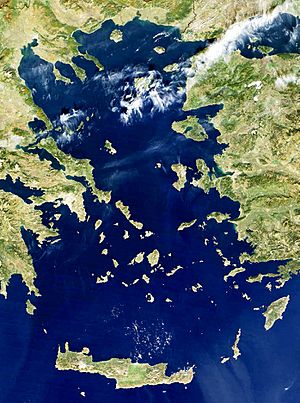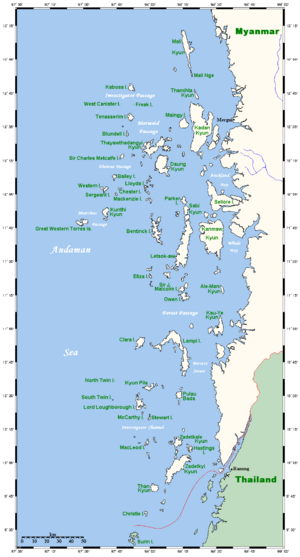Archipelago facts for kids


An archipelago (say ar-kuh-PEL-uh-goh) is a group of islands clustered together in a sea or ocean. Think of it like a chain or collection of islands. Sometimes, the word can also mean a sea that has many scattered islands within it.
Many famous places are archipelagos! Some examples include the Hawaiian Islands, the Galápagos Islands, the Japanese Archipelago, and the Maldives. Even the British Isles are an archipelago. Sometimes, what we call an archipelago can be decided by country borders, not just geography.
Contents
What Does "Archipelago" Mean?
The word archipelago comes from Ancient Greece. It combines two old Greek words: arkhi- meaning "chief" or "main," and pélagos meaning "sea." So, it originally meant "chief sea."
In ancient times, "Archipelago" was the special name for the Aegean Sea. This sea has a huge number of islands. Over time, people started using the word to describe the islands themselves, not just the sea. That's how it came to mean a group of islands.
Different Kinds of Archipelagos
Archipelagos can be found far out in the middle of an ocean or very close to a large piece of land. For example, Scotland has over 700 islands around its mainland, forming its own archipelago.
These island groups often form because of volcanoes. They can appear along island arcs, which are curved lines of volcanoes created when one tectonic plate slides under another. They can also form over hotspots, which are places where hot molten rock rises from deep inside the Earth. But archipelagos can also be shaped by erosion (wearing away of land), deposition (when sediment settles), or when land rises up.
Based on how they were formed, islands in an archipelago can be called oceanic islands, continental fragments, or continental islands.
Oceanic Islands
Oceanic islands are mostly formed by volcanoes. They are usually very far from any large continent. Good examples are the Hawaiian Islands and the Galápagos Islands in the Pacific Ocean. The Mascarene Islands in the southern Indian Ocean are another example.
Continental Fragments
Continental fragments are pieces of land that have broken off from a larger continent. This happens because of tectonic plate movements. The Farallon Islands off the coast of California are an example of these kinds of islands.
Continental Archipelagos
These are groups of islands found close to the coast of a continent. They are considered continental archipelagos when they are part of the same continental shelf. This means the islands are just the parts of the shelf that are above the water. The islands of the Inside Passage off the coast of British Columbia and the Canadian Arctic Archipelago are great examples.
Artificial Archipelagos
Did you know that some archipelagos are man-made? People have built artificial island groups for different reasons. For example, the Palm Islands and The World Islands near Dubai were created for fun, tourism, and luxury resorts. In the Netherlands, Marker Wadden is an artificial archipelago built to create a safe home for birds and other wildlife.
Big Archipelagos
The largest country in the world that is made up of an archipelago, both by land area and by how many people live there, is Indonesia.
See also
 In Spanish: Archipiélago para niños
In Spanish: Archipiélago para niños


